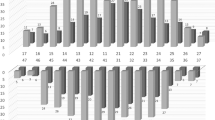Abstract
Dentin hypersensitivity (DH) may be present in association with gingival recession. The aim of this study was to determine quantitatively the association of gingival recession and other factors with the presence of DH. One hundred and four Japanese subjects with or without gingival recession were randomly selected. Intact canines and/or first premolars in both maxillary and mandibular quadrants were analyzed. Gingival recession was measured as a vertical length at the buccal site of the teeth. DH was recorded as an ordered categorical variable registering four increasing levels of pain after cold stimulation; from no discomfort to severe pain during and after stimulation (DH1, 2, 3, and 4). Association of DH with periodontal parameters and daily lifestyle was also investigated. Tooth-based analysis of 446 teeth from 104 subjects revealed that DH level was significantly higher in recessive teeth (1, 2, 3, and 4–8 mm) than in non-recessive teeth (0 mm). DH-positive rate in non-recessive teeth was only 18 % (DH1; 14 %, DH2; 3 %, and DH3; 1 %). Highest DH level was observed in teeth with severe recession (4–8 mm), showing DH0; 21 %, DH1; 33 %, DH2; 31 %, and DH3; 15 %. Recession-dependent increase in DH was observed, showing 18, 49, 52, 60, and 79 % DH-positive in teeth with 0, 1, 2, 3, and 4–8 mm recession, respectively. Plaque-free teeth showed a higher DH level than plaque-stained teeth, suggesting that good plaque control may be associated with the presence of DH. There were no significant differences in DH of teeth on the basis of smoking, probing depth, and bleeding on probing. Multiple logistic regression analysis revealed that gingival recession [odds ratio (OR) = 10.2, 95 % confidence interval (CI) = 5.5–18.9] and plaque deposition (OR = 0.3, 95 % CI = 0.2–0.5) were significant contributors to DH. Multilevel modeling analysis revealed that not only gingival recession and plaque deposition but also V-shaped cervical notch and tooth brushing frequency were associated with DH. These results demonstrate that the progression of gingival recession, plaque-free teeth, V-shaped cervical notch, and frequent brushing may be significant predictors of DH in canines and first premolars.




Similar content being viewed by others
References
Orchardson R, Gillam DG. Managing dentin hypersensitivity. J Am Dent Assoc. 2006;137:990–8.
Canadian advisory board on dentin hypersensitivity. Consensus-based recommendations for the diagnosis and management of dentin hypersensitivity. J Can Dent Assoc. 2003;69:221–6.
Walters PA. Dentinal hypersensitivity: a review. J Contemp Dent Prac. 2005;6:107–17.
Porto ICC, Andrade AKM, Montes MAJR. Diagnosis and treatment of dentinal hypersensitivity. J Oral Sci. 2009;51:323–32.
Dababneh RH, Khouri AT, Addy M. Dentine hypersensitivity—an enigma? A review of terminology, epidemiology, mechanisms, aetiology, and management. Br Dent J. 1999;187:606–11.
Que K, Ruan J, Fan X, Liang X, Hu D. A multi-centre and cross-sectional study of dentine hypersensitivity in China. J Clin Periodontol. 2010;37:631–7.
Chabanski MB, Gillam DG, Bulman JS, Newman HN. Prevalence of cervical dentine sensitivity in a population of patients refereed to a specialist periodontology department. J Clin Periodontol. 1996;23:989–92.
Bevenius J, Lindskog S, Hultenby K. The micromorphology in vivo of the buccocervical region of premolar teeth in young adults. A replica study by scanning electron microscopy. Acta Odont Scand. 1995;52:323–34.
Tugnait A, Clerehugh V. Gingival recession—its significance and management. J Dent. 2001;29:381–94.
Sarfati A, Bourgeois D, Katsahian S, Mora F, Bouchard P. Risk assessment for buccal gingival recession defects in an adult population. J Periodontol. 2010;81:1419–25.
Addy M, Mostafa P, Newcombe RG. Dentine hypersensitivity: the distribution of recession, sensitivity and plaque. J Dent. 1987;15:242–8.
Addy M. Etiology and clinical implications of dentine hypersensitivity. Dent Clin North Am. 1990;34:503–14.
Rees JS, Jin LJ, Lam S, Kudanowska I, Vowles R. The prevalence of dentine hypersensitivity in a hospital clinic population in Hong Kong. J Dent. 2003;31:453–61.
Rees JS, Addy M. A cross-sectional study of buccal cervical sensitivity in UK general dental practice and a summary review of prevalence studies. Int J Dent Hygiene. 2004;2:64–9.
Tarbet WJ, Silverman G, Stolman JM, Fratarcangelo PA. Clinical evaluation of a new treatment of dentinal hypersensitivity. J Periodontol. 1980;51:535–40.
Clark GE, Troullos ES. Designing hypersensitivity clinical studies. Dent Clin North Am. 1990;34:531–44.
Nagata T, Ishida H, Shinohara H, Nishikawa S, Kasahara S, Wakano Y, Daigen S, Troullos ES. Clinical evaluation of a potassium nitrate dentifrice for the treatment of dentinal hypersensitivity. J Clin Periodontol. 1994;21:217–21.
Greene JC, Vermillion JR. The simplified oral hygiene index. J Am Dent Assoc. 1964;68:7–13.
Holland GR, Narhi MN, Addy M, Gangarosa L, Orchardson R. Guideline for the design and conduct of clinical trials on dentine hypersensitivity. J Clin Periodontol. 1997;24:808–13.
Taani SD, Awartani F. Clinical evaluation of cervical dentine sensitivity (CDS) in patients attending general dental clinics (GDC) and periodontal specialty clinics (PSC). J Clin Periodontol. 2002;29:118–22.
Fischer C, Fischer RG, Wennberg A. Prevalence and distribution of cervical dentine hypersensitivity in a population in Rio de Janeiro, Brazil. J Dent. 1992;20:272–6.
Liu HC, Lan WH, Hsieh CC. Prevalence and distribution of cervical dentine hypersensitivity in a population in Taipei, Taiwan. J Endod. 1998;24:45–7.
Bamise CT, Olisile AO, Oginni AO. An analysis of the etiological and predisposing factors related to dentin hypersensitivity. J Contemp Dent Pract. 2008;9:52–9.
Al-Wahadni A, Linden GJ. Dentine hypersensitivity in Jordanian dental attenders: a case control study. J Clin Periodontol. 2002;29:688–93.
West NX. Dentine hypersensitivity: preventive and therapeutic approaches to treatment. Periodontol 2000. 2008;48:31–48.
Acknowledgments
This study was supported by a research grant-in-aid for scientific research from the Ministry of Education, Culture, Sports, Science and Technology, Tokyo, Japan (No. 20791614). The authors report no conflict of interest related to this study.
Author information
Authors and Affiliations
Corresponding author
Rights and permissions
About this article
Cite this article
Fukumoto, Y., Horibe, M., Inagaki, Y. et al. Association of gingival recession and other factors with the presence of dentin hypersensitivity. Odontology 102, 42–49 (2014). https://doi.org/10.1007/s10266-012-0099-5
Received:
Accepted:
Published:
Issue Date:
DOI: https://doi.org/10.1007/s10266-012-0099-5




